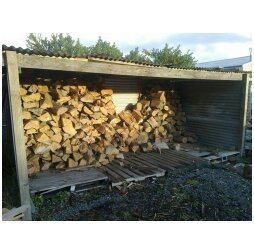So often when someone has an issue with the performance of their wood burning fire we find it is either a fault of the fuel, the operator or the method of operation. Poor quality or wet fuel causes low heat, smoke, creosote build-up and dirty glass, not to mention great anxiety caused to the operator.
Rule ONE: “Only ever use good quality dry fire wood”
Freshly cut wood can have 60% moisture content. Seasoned firewood with a moisture content of less than 25% is easier to start, produces more heat, and burns cleaner.Dry firewood
The best way to be sure you have good wood when you need it is to get your wood early, well before you intend to burn it, and store it properly. The length of time for it to dry depends on the type of wood and how wet it is. Softwoods, like pine and macrocarpa, normally take 6-12 months. Hardwoods like gum can take up to 18 months.Some sellers may be able to tell you the moisture content of the wood (if they have a moisture content meter). Wet or unseasoned wood is cheaper to buy, but you need to have the space to store it for up to a year or more, until it’s dry enough to burn. Some firewood suppliers sell pre-dried wood. It might cost more, but the extra heat it provides could outweigh the extra cost.
Is the wood split? Wood will dry faster if pre-split.
Checking if the firewood’s dry. Dry firewood has cracks in the ends and weighs less than wet wood.
Ways to test if wood is dry enough to burn well are to bang two pieces together;
- dry wood should make a loud, hollow crack
- or to tap the wood with a key or coin; the dry wood should make a sharp, resonant sound
- put a small piece of wood on glowing embers in your wood burner, the top and sides should catch fire in less than a minute.
Well-seasoned firewood generally has darkened ends, is relatively lightweight, and makes a clear "clunk" when two pieces are knocked together. Bark usually peels off easily from aged wood.
Signs that your firewood is not dry enough: The wood is hard to light and hisses and sizzles. The fire produces more smoke than heat.
Storage
Even if your firewood is dry, storing it well will keep it that way. Here’s how:Split large bits of wood into pieces no more than 10-15cm thick, although at Firenzo we use huge chunks to feed our Viking in the show room. Remove bark, or stack the wood with the bark at the bottom, so the moisture can evaporate. Bark slows down the drying process.
Stack the wood in a covered, well-ventilated area with a roof or tarpaulin.
Seasoned wood will usually not be affected by small amounts of rain. Wet wood throws off less heat when burned and contributes to creosote build-up and pollution.
Get an annual chimney check. Have chimneys inspected annually, and cleaned as necessary, by a qualified professional chimney service technician. This reduces the risk of fires and carbon monoxide poisonings due to creosote build-up or obstructions in the chimneys.Back...


